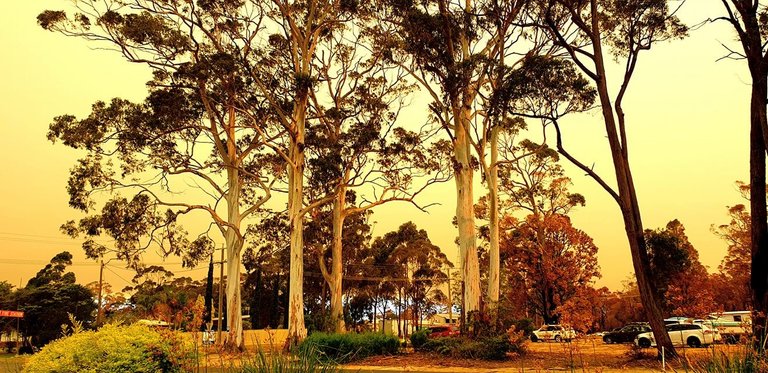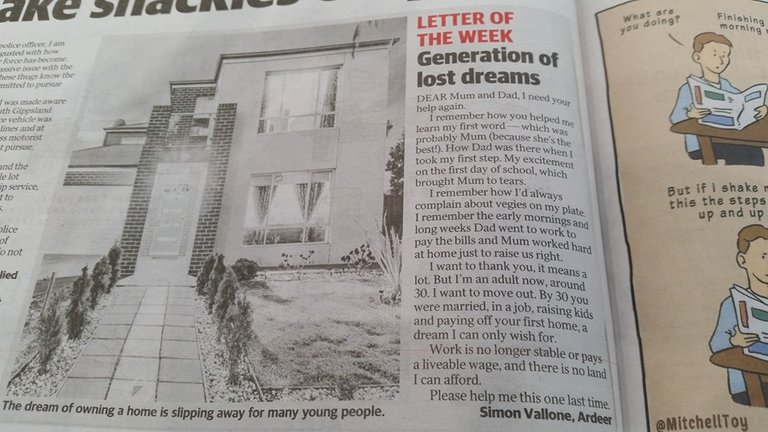
The Perfect Australian Storm: Floods, Fire, Pandemic and a generation out of cash
The cost of living crisis currently experienced by many in Australia leaving our budget destroyed isn’t slowing down. Over the past few days you have read how we first discussed the current Melbourne Paradox but in truth the housing crisis first emerged in the 2008 Financial crisis brought on by Stock Exchange bubble loans. People turned to Australian property to safeguard their wealth. This was an issue I have been long advocating for with many back then not hearing the calls to action and now we are here with 74% of households in Australia in rental and mortgage stress.
I also recently spoke about how the Millennial Cash Cow is Now Dead for a big part the Australian Governments approach was to tax and increase costs for the next generations. But the current economic climate has now finally thrown the last punch in this failed strategy that has created the first time in history that a future generation has had it worse than the previous (looking at you boomers)..
The interesting aspect of that is that it is usually the next generation that funds the previous generations retirement, but we have created a scenario where now the previous generation will have to fund both their retirement and the next generation. But, if this current time in history tells us anything is that they wont and we will all burn. (news flash we are).
If you’re expecting a wealth transfer which is estimated at 50 Trillion you’re wrong the wealthiest generation in human history won’t be passing it onto you as they will require that in health care. If future generations expect the same level of health that boomers are about to get, you won’t either. Yes, it is all dire. Perhaps Gen X and Gen Y can learn from this and ensure it doesn’t happen to our kids. What’s the solution? Ask you’re member of parliament, it’s their job.
The other aspect of the current economic crisis as they say bad things happen in three’s and has thrown a spanner and not one of those small ones. We’re talking those massive spanners used on jet engines in the 60s. Is that Australia has been grappling with a series of natural disasters that have converged to form a perfect storm, severely impacting the economy and exacerbating an already pressing cost of living crisis. The combination of the COVID-19 pandemic, climate change, war and extreme weather events has created a multifaceted crisis that is driving inflation and making everyday life increasingly unaffordable for many Australians.
Disrupted Supply Chains
The COVID-19 pandemic exposed and intensified existing vulnerabilities within global supply chains. According to research by Ernst & Young (EY) the pandemic highlighted weaknesses such as staff shortages and the fragility of long, linear supply chains. The pandemic's disruption necessitated a shift towards more resilient, collaborative and digitally-enabled supply networks, but with the current war outbreaks. This transition, while necessary involves significant costs, peace talks which no on is looking at addressing any time soon.
In Australia, the pandemic's effects were compounded by the nation's geographical isolation, which already posed challenges to supply chain efficiency. National lockdowns and border restrictions further slowed or halted the flow of goods, exacerbating shortages and driving up costs.

Extreme Weather Events and Their Impacts
Climate change has introduced another layer of complexity to the supply chain issues. The food supply chain, in particular is highly susceptible to climate related disruptions. The increased frequency and intensity of extreme weather events such as floods, droughts, bushfires and cyclones have profound impacts on agriculture, fisheries, and livestock production.
Research from the University of Sydney highlights how extreme weather events can create a 'domino effect' on food supply chains. For instance, a cyclone in Queensland not only affects local food production but also has ripple effects across other states due to the interconnected nature of supply chains. These disruptions lead to reduced food availability, job losses and income declines in affected areas, contributing to higher food prices nationwide.
Australia's agricultural sector is particularly vulnerable to climate change. Rising temperatures, altered precipitation patterns while extreme weather events have reduced crop yields and livestock productivity. This is in line with global trends identified by the Intergovernmental Panel on Climate Change (IPCC) which predicts significant declines in yields of major crops like rice, wheat and maize due to climate stressors.
Increased food prices directly impact the cost of living. As the prices of staple foods rise, urban consumers who rely heavily on purchased food due to the ever decreasing land size, bear the brunt of the cost increases. Additionally, the quality of available food is often compromised, leading to poor nutritional outcomes and further stress on public health systems, these areas are called food deserts.
Inflation and Economic Stress
The convergence of these factors has driven inflation to new heights. The disruption of supply chains, combined with reduced agricultural output and increased production costs, has pushed prices up across the board. According to the Reserve Bank of Australia, inflation has been exacerbated by supply chain bottlenecks and increased demand as the economy recovers from the pandemic-induced recession. The RBA responds by increased interest rates which directly negatively impact Gen Y and X. Which, isn’t working because we’re already broke.
Moreover, the costs associated with transitioning to more resilient and sustainable supply chains necessary to mitigate future disruptions are being passed on to consumers (Gen Y and X). Investments in technologies like AI, automation and advanced analytics, while critical for future resilience require substantial upfront capital that businesses are recouping through higher prices.
The economic fallout from these natural disasters and supply chain disruptions has significant social implications. The rising cost of living is hitting vulnerable populations the hardest. Low-income households spend a larger proportion of their income on essentials such as food and energy, making them more susceptible to price increases. The University of Sydney study proves how climate change exacerbates existing inequalities with the poorest communities bearing the heaviest burden
Government and Policy Response
Addressing these challenges requires a multifaceted approach. Policymakers must focus on enhancing supply chain resilience, investing in sustainable agricultural practices and supporting the most affected communities while backing off putting all those costs on Gen X & Y. Initiatives to improve supply chain visibility, efficiency and sustainability are crucial. This includes leveraging digital technologies and fostering greater collaboration among supply chain stakeholders to anticipate and mitigate disruptions.
Furthermore, policies aimed at climate adaptation and mitigation are essential. This involves investing in infrastructure to withstand extreme weather, promoting sustainable farming practices, and ensuring that emergency response mechanisms are robust and well-coordinated.
Australia is facing a complex and multifaceted crisis driven by the convergence of natural disasters, climate change, War, pandemic induced supply chain disruptions and a dead cash cow (Gen Y & X). The resulting inflation and cost of living increases are putting significant strain on households (except Boomers who hold 53% of the nations wealth) and businesses alike. Addressing these challenges requires coordinated efforts to enhance supply chain resilience, promote sustainability and support vulnerable communities and create new mechanisms beyond the failed Reserve Bank Of Australia whose attempts have only caused further pain and fail and bringing inflation under control. Only through such comprehensive measures can Australia hope to navigate this perfect storm and build a more resilient and equitable future.
Looking for a solution? Contact your local member of parliament, it’s their job.
image sources provided supplemented by Canva Pro Subscription.
Posted Using InLeo Alpha

We are indeed getting screwed at many different directions and it’s incredibly annoying and frustrating. It certainly feels like a planned destruction of it all, as challenging as that may seem. We know they love and want more control at every level, and in order to do that they have a to get rid of pesky cash and then home ownership.
I will vehemently disagree with you on the “climate change” aspect though. This is simply weather, and it is NEVER consistent, and never will be. We are living in a bit of a golden age as far as temperature and it’s amusing how the narrative changes. In the 60’s it was global cooling, then it was global warming, then it was climate change, now it’s the climate emergency. There have been numerous predictions, catch phrases and the like but all trying to push an idea of destruction and death. For example the Great Barrier Reef was said to be bleaching and dying, set to disappear in the next few years yet I think it was last year it grew to its biggest extent on record.
We should be aware of their fear matrix but don’t subscribe to believing any of their predictions and fear they are pushing. It’s their playbook, fear, division, destruction in order to take more control.
The “climate” will never be consistent, and these storms and weather events have far more complication to them. If you are interested Randall Carlson does an amazing job of explaining this quite eloquently, with legitimate scientific papers and historical records. He runs a great podcast Kosmographia that I’ve listened to a few dozen episodes of, and it will help us realize the weather is far more complicated than carbon dioxide, which is CRITICAL for plants like crops by the way.
Last note - carbon dioxide levels right now I believe are around 450 parts per million. All plant life dies below 120 parts per million of CO2 and the world has existed and thrived at 6,000 parts per million C02 according to core samples and fossil records. Carbon is NOT the problem.
It is hard to dispute that CO2 isn't on the rise since the industrial revolution. Global Cooling is technically the correct response as the increased co2 increases heat which melts polar ice caps which then floods the world and cools the planet causing an ice age. This is a natural cycle but over millions of years, we are making it happen a hell of a lot faster.
But global cooling doesn't hit the same especially when everything is currently getting hotter.